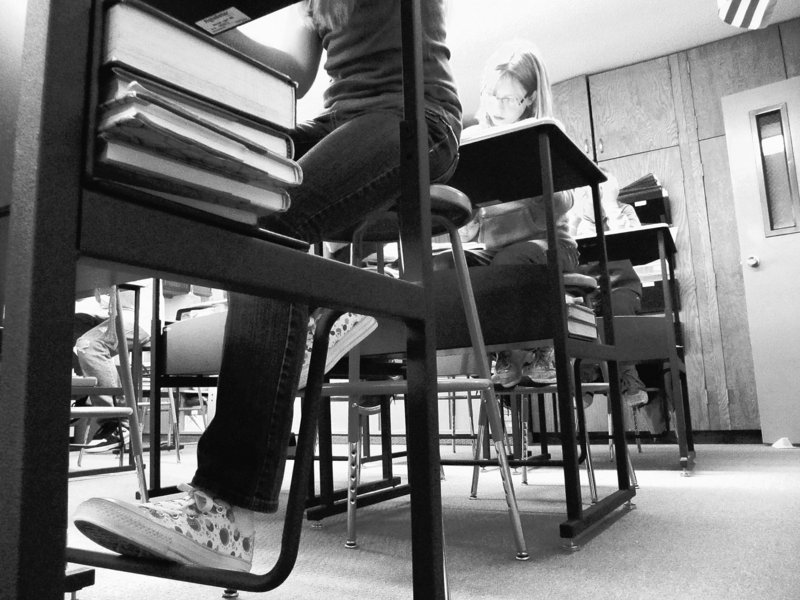IDAHO FALLS, Idaho — In a handful of classrooms nationwide, students are learning to think on their feet.
Sixth-graders at a small private school in southern Idaho stand while crunching math problems. They lean over waist-tall workstations to compare answers with classmates. And whenever they feel the need to sit, they prop themselves up onto tall stools and slip their sneakers into swinging footrests, rocking them back and forth.
“It’s not normal for students, or even necessarily for adults, to sit still for long periods of time,” their teacher Jim Oloff said.
In states such as Idaho, Minnesota and Wisconsin, some teachers have replaced the standard classroom desk with height-adjustable workstations, which they hope will offer notorious fidgeters some relief for their antsy tendencies.
Hope Lutheran School in southeastern Idaho has taken the trend a step further.
During math, Dylan Trowbridge, 11, stood for the most of the lesson. His classmate 12-year-old Jane Hula sat with one leg swinging her footrest back and forth. In the front of the room, 11-year-old Anya Brown was perched on her stool.
“They give you more room so I don’t get cramped in one place,” Brown said.
Twice a month, Oloff’s sixth-graders step on a scale and a researcher from a federal laboratory records their weight and height.
The kids clip pedometers onto their belts each day when class starts and record how many steps they’ve taken before they leave — information that can be used to determine how active they are and how many calories they’ve burned.
The Idaho National Laboratory has been collecting data since January and while the students think they’re part of a fitness study, Oloff has also been monitoring their attention and concentration skills, along with how well they interact.
The lab is collaborating with the Mayo Clinic on the study, which will compare students before and after the so called “stand-up” desks were installed. The lab plans to release the findings in October.
Researchers for years have studied the stand-up desks with adults, who in some cases work at stations fitted over standard treadmills, but the data being collected from Idaho students could provide crucial information on how this works in the classroom, said Dr. James Levine, an obesity researcher at the Mayo Clinic in Rochester, Minn.
Could the stand-up desks play a role in the fight against childhood obesity? Do students really focus better when they’re allowed to move around a bit?
“It’s the first, real-world, large-scale study of what will be the future of education,” said Levine, who purchased a used Sears treadmill for $350 and assembled his own walking desk after publishing a study that found that thin people were on their feet an average of two hours more and burned 350 more calories daily than obese people.
Things as small as pacing or fidgeting made a difference, according to the study.
“I’m one of these people that’s 100 percent positive the obesity epidemic can end,” said Levine, who walks a mile each hour at his desk.
The workstations’ cost — anywhere from $250 to $500 — presents a problem with money tight at schools around the county.
The Idaho school raised about $2,500 from local businesses and donors to buy 10 desks from the Wharton, N.J.-based company VisualEd Tech, Inc., said Oloff.
The school later contacted the Idaho National Laboratory to find out if the new desks would work. Brad Snedden, the lab’s disease and injury prevention coordinator, was intrigued.
“We’re going to see whether or not we’ve had some measurable changes,” said Snedden.
Since January, some of the kids have gotten taller and their weight hasn’t changed. Others are losing weight but not getting taller, Snedden said.
“What’s most important, especially since we’re dealing with youth, is we’re seeing an increase in activity,” Snedden said, “which is going to translate to healthier adults.”
Copy the Story Link
Send questions/comments to the editors.



Success. Please wait for the page to reload. If the page does not reload within 5 seconds, please refresh the page.
Enter your email and password to access comments.
Hi, to comment on stories you must . This profile is in addition to your subscription and website login.
Already have a commenting profile? .
Invalid username/password.
Please check your email to confirm and complete your registration.
Only subscribers are eligible to post comments. Please subscribe or login first for digital access. Here’s why.
Use the form below to reset your password. When you've submitted your account email, we will send an email with a reset code.